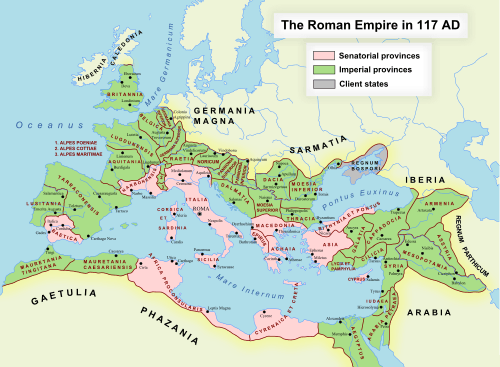Sicilia (Roman province)
| Provincia Sicilia | |||||
| Province of the Roman Empire | |||||
| |||||
 | |||||
| Capital | Siracusa | ||||
| Historical era | Antiquity | ||||
| • | Established after the end of First Punic War | 241 BC | |||
| • | Fall of the Western Roman Empire | 476 AD | |||
| Today part of | | ||||
Sicilia was the first province acquired by the Roman Republic, organized in 241 BC as a proconsular governed territory, in the aftermath of the First Punic War with Carthage. It included Sicily and Malta, but not the city of Syracuse, on the east coast. (Syracuse remained an independent ally of Rome until after the Second Punic War).[1]
History
During the Second Punic War, Syracuse was allied with Hannibal, but was taken by the Roman commander Marcellus in 212 BC, and was absorbed into the already existing province. It was divided into two quaestorships, Syracuse and Lilybaeum. The Latinizing of the island continued, though the Greek element never entirely disappeared.[2]
It was very important during the republican period for its role in supplying grain to the city of Rome,[2] however it started to lose importance with the conquest of Africa and especially with the annexation of the Ptolemaic kingdom. Nevertheless, the province was to regain its importance centuries later, when Rome lost control over these areas and was forced to turn back to Sicily for her needs.
The land fell into the hands of a few great landholders, who cultivated the rich soil by the labour of immense bands of slaves. These slaves rebelled in 135 in the First Servile War, proclaiming Eunus, one of their number, king. Eunus defeated the Roman army several times, but in 133 he was vanquished by Rufilius near Messina; the war ended with the capture of Tauromenium and Enna (132), and about 20,000 of the unfortunate slaves were crucified. The Second Servile War occurred between 103 and 100 under "King Trypho" and the leadership of Athenio.[2]
Sicilia remained a province of the Roman Republic and Roman Empire for six centuries. It was Important for its grainfields, which were a mainstay of the food supply for the city of Rome.[3] Latin speakers from the mainland were settled mainly in the western part of the island. The empire did not make a deliberate much effort to Romanize the region, which remained largely Greek-speaking in the east. A notable event affecting Sicilia in the Late Republic was the notorious misgovernment of Verres, as prosecuted by Cicero in 70 BC in his speech In Verrem.
The historian Diodorus Siculus and the poet Calpurnius Siculus both came from Sicilia, as indicated by the surname Siculus. The most famous archeological remains of this period are the mosaics of a nobleman's villa in present-day Piazza Armerina.
Sicilia was home to one of the earliest Christian communities and some of the earliest Christian martyrs, including Saint Agatha of Catania and Saint Lucy of Syracuse.
In 468 Sicilia fell to the Vandal King Geiseric but reunited with Italy in 476 under Odoacer with a toe-hold allowed in the port of Lilybaeum.[4]
See also
Notes
- ↑ Cartwright, Mark. "Syracuse", Ancient History Encyclopedia, 28 April 2011
- 1 2 3 Umberto Benigni, "Sicily." The Catholic Encyclopedia, Vol. 13 (New York: Robert Appleton Company, 1912). Last accessed: 30 May 2014
- ↑ Lithgow, William (1770). Travels and Voyages Through Europe, Asia, and Africa, for Nineteen Years .... J. Meuros. p. 256-263.
- ↑ J. B. Bury, The History of the Later Roman Empire, pp. 254, 327, 333, 336 and 410; John Moorhead, Theodoric in Italy (Oxford University Press, 1992), p. 9.
External links
- Wilson, R., R. Talbert, T. Elliott, S. Gillies. "Places: 462492 (Sicilia)". Pleiades. Retrieved March 8, 2012.
